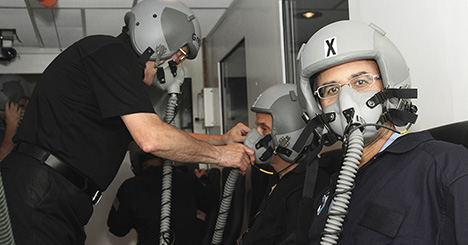

Today’s piston-powered aircraft flown for business can easily carry their pilots and passengers to altitudes where the FAA recommends the use of supplemental oxygen. FAA Advisory Circular AC 61-107B, which addresses high-altitude flight, says, “Although oxygen is not required below 12,500 feet MSL… we recommend its use when flying unpressurized above 10,000 feet MSL during the day and above 5,000 feet MSL at night, when the eyes become more sensitive to oxygen deprivation.”
Mention supplemental oxygen and most pilots think of the altitude requirements of 12,500 and 14,000 feet, said Dr. Brent Blue, a board-certified emergency and family physician and senior aviation medical examiner who introduced aviation to the pulse oximeter, which takes fingertip readings of oxygen saturation. Supplemental oxygen altitude requirements, created in the 1950s, are based on geography, not physiology, said Dr. Blue. “They let you fly anywhere in the contiguous United States without having to climb to 14,000 feet, and you can fly through mountain passes at 12.5 in less than 30 minutes.”
However, hypoxia (the insufficient supply of oxygen to the body) and how flying at altitude affects people, depends on factors that include health, habits, diet, fatigue and where they live, noted Dr. Blue. For example, those who reside at sea level are more susceptible than mountain dwellers. And the carbon monoxide (CO) inhaled while smoking a single cigarette reduces the blood’s oxygen-carrying capacity for eight hours, he explained, which is why a cockpit CO monitor is an essential piece of equipment.
A pulse oximeter should also be standard equipment for pilots flying piston-powered aircraft at high altitudes (Dr. Blue recommends American-made units for their reliable accuracy). Working from a baseline saturation level measured at their home airport (usually 95 to 100 percent at sea level), “Pilots should use supplemental oxygen when that number falls five points, and they must use oxygen when their saturation level drops 10 points.” In both cases, they must adjust the oxygen flow until they saturate back to their home-airport baseline.
Hypoxia (the insufficient supply of oxygen to the body) and how flying at altitude affects people, depends on factors that include health, habits, diet, fatigue and where they live.
A mask uses oxygen more efficiently than a nasal cannula, and Alex Gertsen, NBAA’s director of airports and ground infrastructure, who uses both in his Turbo Mooney, donning the mask on flights above 14,000 feet. (Dr. Blue advises switching back to a cannula to eat or drink at altitude.) Gertsen carries portable oxygen to back up and extend his installed system, and his preflight checklist includes a passenger briefing and system check. More than verifying system pressure during preflight, he confirms the consistent flow of oxygen. Gertsen carries a second pulse oximeter to enable passengers to monitor their oxygen levels and adjust their flowmeters.
It’s important for pilots to understand the potential dangers of hypoxia. Educational courses can teach aviators about hypoxia’s physiological and operational impacts, and the symptoms and debilitating effects of the condition can be demonstrated in an altitude chamber.
Sebastian Strzyzewski, chief instructor for aviation and advanced pilot training at the Environmental Tectonics Corporation’s National Aerospace Training and Research Center, said, “A well-trained pilot is the most important component of any supplemental oxygen system.”
What Piston Airplane Pilots Should Know About Oxygen
- Aviators should know hypoxia’s performance-reducing physiological impacts
- The effect of flying at altitude depends on health, habits, diet, fatigue and where an individual lives
- Masks use oxygen more efficiently than nasal cannulas
- The FAA doesn’t require supplemental oxygen below 12,500 feet MSL, but the agency recommends using it when flying unpressurized above 10,000 feet
- MSL during the day and above 5,000 feet


 International Business Aviation Council Ltd.
International Business Aviation Council Ltd.